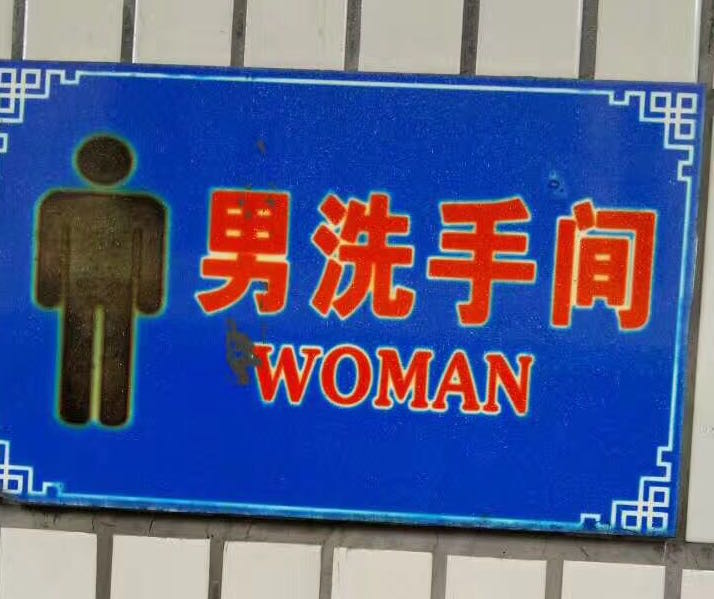M & W WC
« previous post | next post »
Zeyao Wu took these two pictures in Guangzhou. She found these signs in a small market which sells vegetables and fruits.
This question is for those readers who are not familiar with Chinese characters:
Which would you trust more, the male and female figures or the English words?
Here's what the Chinese says:
#1 nǚ xǐshǒujiān 女洗手间 ("women's toilet")
#2 nán xǐshǒujiān 男洗手间 ("men's toilet")
Are my English translations correct? It would probably be more common to say "women's room" and "men's room". Is there any better way?
Of course, the usual way would be just to write "Women" and "Men" or "W" and "M", or to use some other clever designations such as those depicted here, here, and here.


BZ said,
September 12, 2017 @ 1:06 pm
I would ask for clarification if possible. If not, I'd follow the figure. The thing is, I'm not at all sure a transposition like this would not happen in the US. See for example https://www.officesignspro.com/images/funny-signs/Road-Signs/arrow-left_keep-right.jpg
Gregory Kusnick said,
September 12, 2017 @ 1:28 pm
I'd look at the people going in and out of each door and trust that.
If nobody has used either door in several minutes, then I guess it doesn't matter much which one I choose.
Philip Taylor said,
September 12, 2017 @ 1:38 pm
'… more common to say "women's room" and "men's room"'. Perhaps more common in North America; in the British Isles we are less reticent about such things and would almost certainly use "toilet" or "lavatory" in preference to the rather ambiguous "room". But as to "clever designations such as this", the problem with that sign is that something very like it is used to designate a lift (<Am.E> 'elevator', I believe), which has certainly caused me confusion in the past.
ohwilleke said,
September 12, 2017 @ 2:21 pm
Off topic but deserving of an Language Log post: http://www.taipeitimes.com/News/taiwan/archives/2017/09/11/2003678239
Fruit names do not invite ghosts.
BZ said,
September 12, 2017 @ 2:21 pm
@Philip Taylor,
Yes, this tripped us up on our trip to Germany. To my US eyes, those pictorial representations can only refer to a restroom or closely related things like showers, changing room, etc, certainly not an elevator.
mg said,
September 12, 2017 @ 3:28 pm
I'd definitely follow the figures. I trust the person making the sign to be able to tell apart male and female icons more than I trust them to know the correct words in a foreign language/alphabet.
Ellen K. said,
September 12, 2017 @ 4:44 pm
Definitely the figures. Of course, that's partly because, thanks to Language Log, I know how bad translations can sometimes be. Whereas it would be much more unusual I think to get the symbols backwards.
David Morris said,
September 12, 2017 @ 5:05 pm
In South Korea, public toilets are very often colour-coded – blue for men and red for women. I note that the figures on the Chinese signs are red and black.
Kasey Chang said,
September 12, 2017 @ 10:09 pm
A casino in California uses "Buck" and "Doe" to designate the male and female restrooms.
Reinhold {Rey} Aman said,
September 13, 2017 @ 12:33 am
Here is my (better) collection of international toilet doors:
http://aman.members.sonic.net/toilets.html
ajay said,
September 13, 2017 @ 3:54 am
in the British Isles we are less reticent about such things and would almost certainly use "toilet" or "lavatory" in preference to the rather ambiguous "room"
We would also say "ladies" and "gentlemen" rather than "women" and "men".
Reinhold {Rey} Aman said,
September 13, 2017 @ 11:15 am
@Kasey Chang:
A casino in California uses "Buck" and "Doe" to designate the male and female restrooms.
Some American waterfront restaurants use "Buoys" and "Gulls" and others use the hunting-dog types "Pointers" and "Setters."
cliff arroyo said,
September 14, 2017 @ 1:58 am
"in the British Isles we are less reticent about such things and would almost certainly use "toilet" or "lavatory""
In the US (for me) using 'toilet' to refer to the room sounds kind of crude… (it usually just refers what people sit on in said room).
I think lavatory passed out of usage in the US because of the phonetic similarity to laboratory (since they rhyme).
In Poland they traditionally used symbols that tend to confuse newcomers, both are shown here
http://www.artdeco.sklep.pl/galerie/o/oznaczenie-toaleta-damsk_17464.jpg
BZ said,
September 14, 2017 @ 10:42 am
In the US, I think it's always "ladies' room" and not "women's", but usually (but not always) "men's room" and not "gentlemen's room". When it's shortened to a single word, "women" becomes available, and slightly preferred over "ladies".
Ellen K. said,
September 14, 2017 @ 1:42 pm
In the U.S. (in my experience) when speaking, if using a gendered term, it would be usually "Ladies' room", but also sometimes "little girls' room". What, if anything, men would say for a gendered term for a public restroom I can't say with confidence, though my instinct is "mens' room". (Apostrophes optional.) The labels on the doors, though, sometimes might be "men" and "women", and sometimes might be "ladies" and "gentlemen". I've no sense of which is more common.
Quinn C said,
September 14, 2017 @ 3:52 pm
BZ: To my US eyes, those pictorial representations can only refer to a restroom or closely related things like showers, changing room, etc, certainly not an elevator.
Looking at them in comparison, I realized for the first time that the vertical bar often seen between the two figures in toilet signs may actually be significant, indicating separate rooms.
speedwell said,
September 15, 2017 @ 9:52 pm
In the summer Irish-language course for adults I attended this year in County Donegal, the teachers playfully explained the reason why "F" and "M" on loo doors caught tourists by surprise (Irish fir, "men", and mná, "women", for those not familiar).
Chas Belov said,
September 16, 2017 @ 8:37 pm
I thought "ladies' room" had been replaced by "women's room" years ago. But I'm in California and there might be regional differences.
Ellen Kozisek said,
September 17, 2017 @ 9:49 pm
To correct my spelling, it would, of course, be "men's room". Which, by analogy, suggests "ladies' room" and "little girls' room" are the correct spellings.